- What Is CRM Reporting & Why It Matters
- Strategies for Effective CRM Reporting
- Advanced Tools for CRM Reporting
- 7 Must-Have CRM Reports for Every SaaS Business
- How to Create a CRM Report
- Best Practices for CRM Reporting and Analytics
- Features for CRM Reporting in 2025
- Ready for Insights? Your CRM Reporting Awaits
CRM Reporting in 2025: Best Practices, Tools, and Must-Have Reports

Co-Founder & CTO
As we approach 2025, the landscape of CRM reporting continues to evolve, making it essential for businesses to stay updated on the latest practices and tools. As part of the Revenue Operations team, you recognize how essential it is to have thorough CRM reporting. CRM reporting enables you to understand each aspect of the go-to-market business. From sales pipeline to marketing lead conversion to customer upsell and retention, CRM reporting lets you dive deep into the weeds of each department while giving you a pulse on the overall health of the business.
However, native CRM reporting is notorious for being difficult to navigate, share across the organization, and analyze complex data sets. We’ll walk through the CRM reporting basics, highlight different reports you should have in your roster for 2025, and provide helpful tips to create meaningful reports that track business results.

What Is CRM Reporting & Why It Matters
CRM reporting is the process of analyzing and summarizing data collected by a Customer Relationship Management (CRM) system. This data can provide valuable insights into sales performance, marketing effectiveness, customer service trends, and customer insights.
CRM reporting has undergone a transformation over the last decade. The explosion of data led to the need for advanced analytics, better visualizations, and additional customizations. Now, with the rise of AI, CRM reporting will more easily automate insights, provide trend predictions, and personalized recommendations for optimization.
Strategies for Effective CRM Reporting
When it comes to CRM reporting and analytics, there are a few tried and true best practices that can set your organization up for success.
- Set clear objectives: Determine the goals of your CRM reporting. This will help you focus your energy on the data points and reports that matter most.
- Tailor reports: The reports your sales team needs will look very different than that of your marketing team. Create department-specific reports to empower each go-to-market team with their own data and insights.
- Automate where possible: Automate data collection and report generation to save you time and to make it easy for those across the organization to access the information they need.
- Integrate other tools: Your CRM is only one side of the story. Your organization likely has other marketing, sales, and finance tools pulling in data that is not being pulled into your CRM. For a true, holistic view of your data, look to integrate your other tools within your CRM reporting, whether that’s within the CRM itself or through a third-party reporting solution.
Try Sightfull for free!
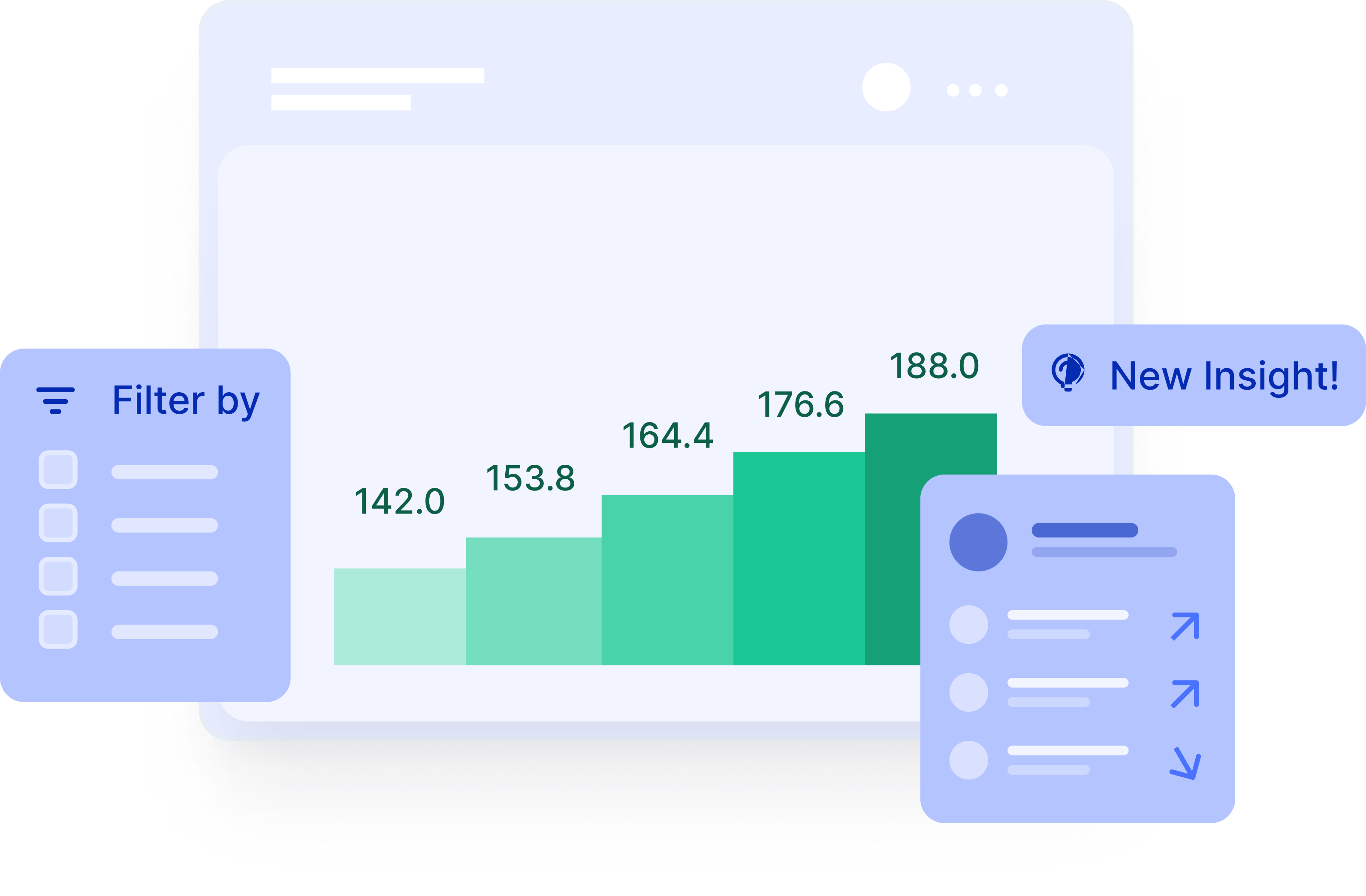
Advanced Tools for CRM Reporting
For advanced CRM reporting, many teams lean on tools, such as third party Salesforce, Hubspot, or Zendesk reporting tools, to help create more complex and intuitive reports. The reporting within CRMs is often limited to basic visualization and simpler data analytics. By leveraging third party tools, teams are able to access additional insights.
Popular reporting tools
Popular tools for CRM reporting include:
- Sightfull is known for its real-time data monitoring, powerful visualizations, and out-of-the-box metrics. Sightfull is a great fit for both growing startups and SaaS enterprise organizations.
- Tableau is a powerful data visualization tool that helps you create interactive dashboards and reports with your CRM data. While it can provide advanced analytics, its customizable solution requires technical knowledge as all reports have to be built from scratch.
- Weflow is designed specifically for Salesforce users, providing a seamless integration with the platform. While it’s great for Salesforce reporting, it does not integrate with as many other data sources compared to other reporting tools.
For a full list of the top-rated CRM reporting tools, check out our article Top 7 Salesforce Reporting Tools to Explore in 2025.
Key features
Ease of use, complex data analysis, and shareability are some of the key features that teams look for in their CRM reporting software. But, it ultimately depends on your company’s needs. When looking for a third-party CRM reporting tool, ask yourself the following to better determine your needs:
- Who will be the users of the reporting tool? Is this for your data analysts or your sales and marketing teams? The user will help you determine how intuitive the platform needs to be.
- What will be the main use case of the reporting tool? Are you looking for more advanced data analysis, the processing of large quantities of data, or ease of use for non-technical users?
- Where will your company be in 3-5 years? While you can’t predict the future, you can take a look at your company’s goals to understand if a third party solution will adequately scale with your company’s future needs.
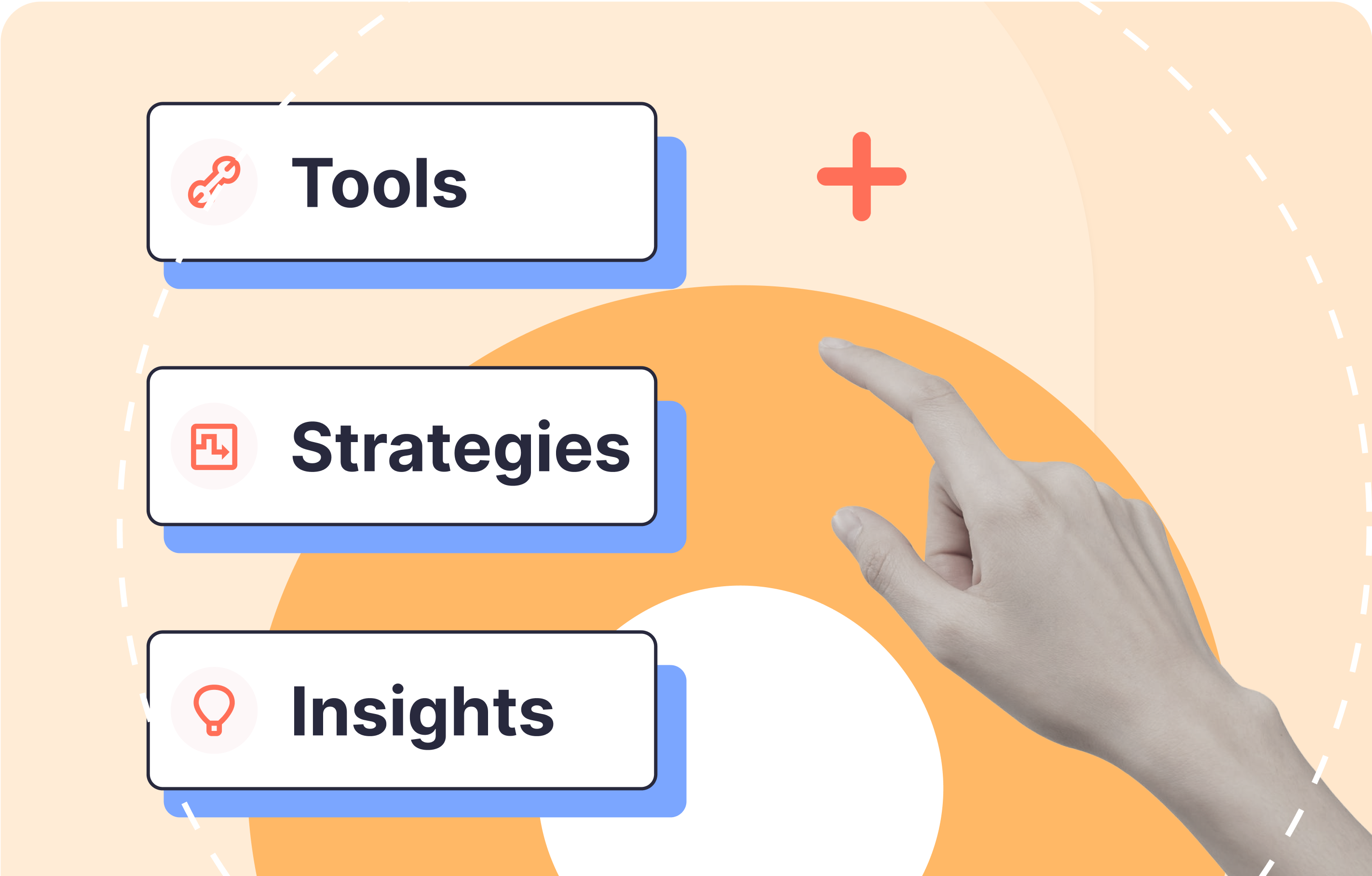
7 Must-Have CRM Reports for Every SaaS Business
While each business will have CRM reports unique to its needs, there are a number of tried and true reports that every SaaS business should be keeping tabs on.
1. Annual Recurring Revenue (ARR) Report
The annual recurring revenue (ARR) is used by SaaS businesses to show the predictable, yearly income they expect from customers. ARR offers a clear view of the development of revenue across different time periods and is a must-have for executive dashboards, finance, and RevOps teams. It can be used as a jumping off point to better understand business performance and dig into revenue trends.
Within an ARR report template, you’ll typically find a few different metrics such as:
- ARR Waterfall: A visual breakdown of how a company's ARR changes over a period, considering new customers, upgrades, downgrades, and churn.
- Net new ARR: The additional ARR gained from new customers after accounting for churned ARR in a specific period.
- New ARR: The ARR generated solely from new customers acquired in a specific period.
- Rolling ARR: The annualized recurring revenue calculated at each point in time, reflecting the latest customer data and changes.
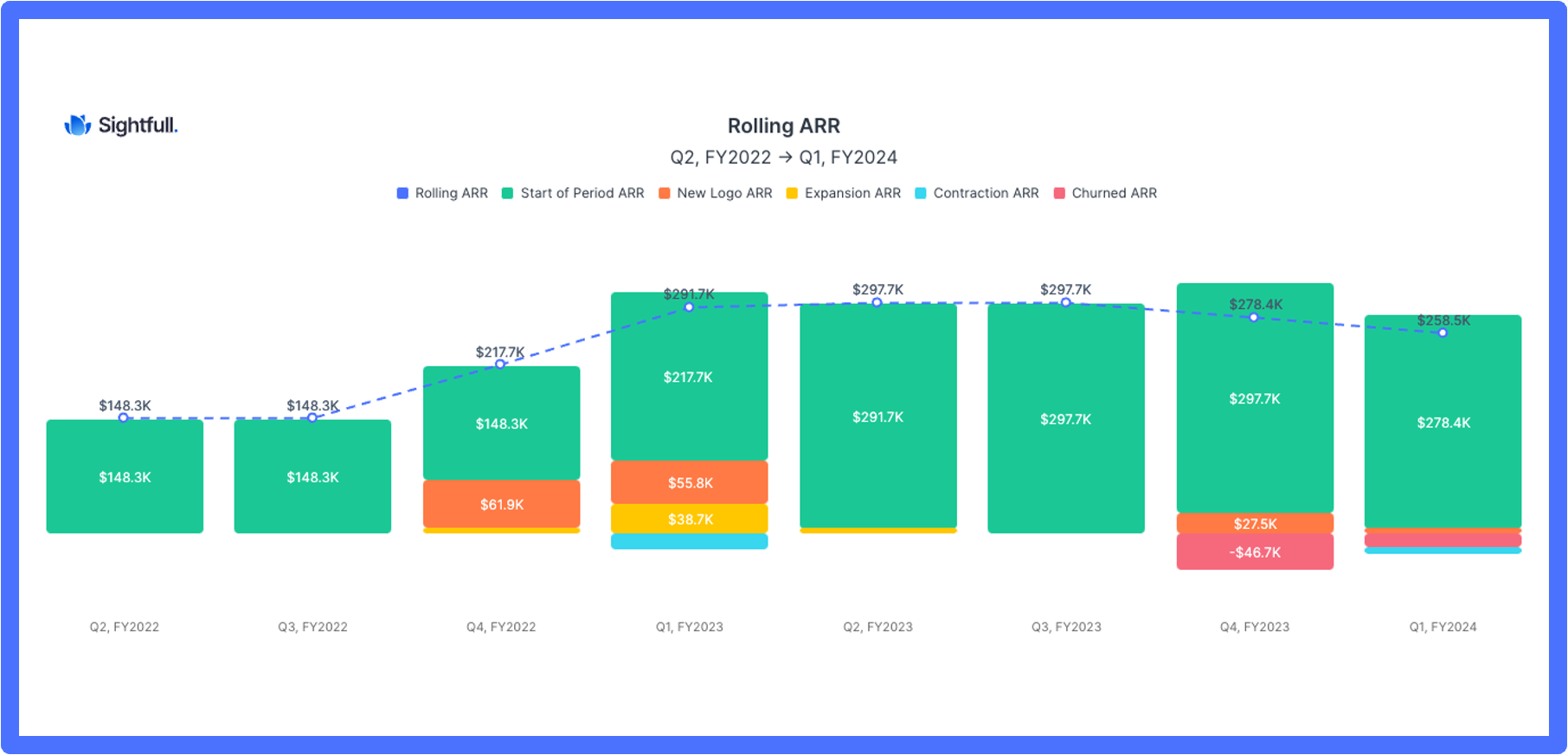
2. Pipeline Analysis CRM Report
The Pipeline Analysis report is key to RevOps teams and those within the go-to-market organization. Pipeline analysis reports typically include information on lead sources, bookings, and the expected close date for each opportunity. The report helps RevOps teams streamline pipeline management, gain revenue predictability, and pinpoint issues, such as bottlenecks or delays, within the sales funnel.
Metrics within a Pipeline Analysis template often include:
- Bookings: The total closed won opportunities for the period.
- Pipeline Creation: The number of new opportunities created within the period.
- Bookings and Pipeline: Combining bookings quarter to date with open pipeline opportunities for the quarter.
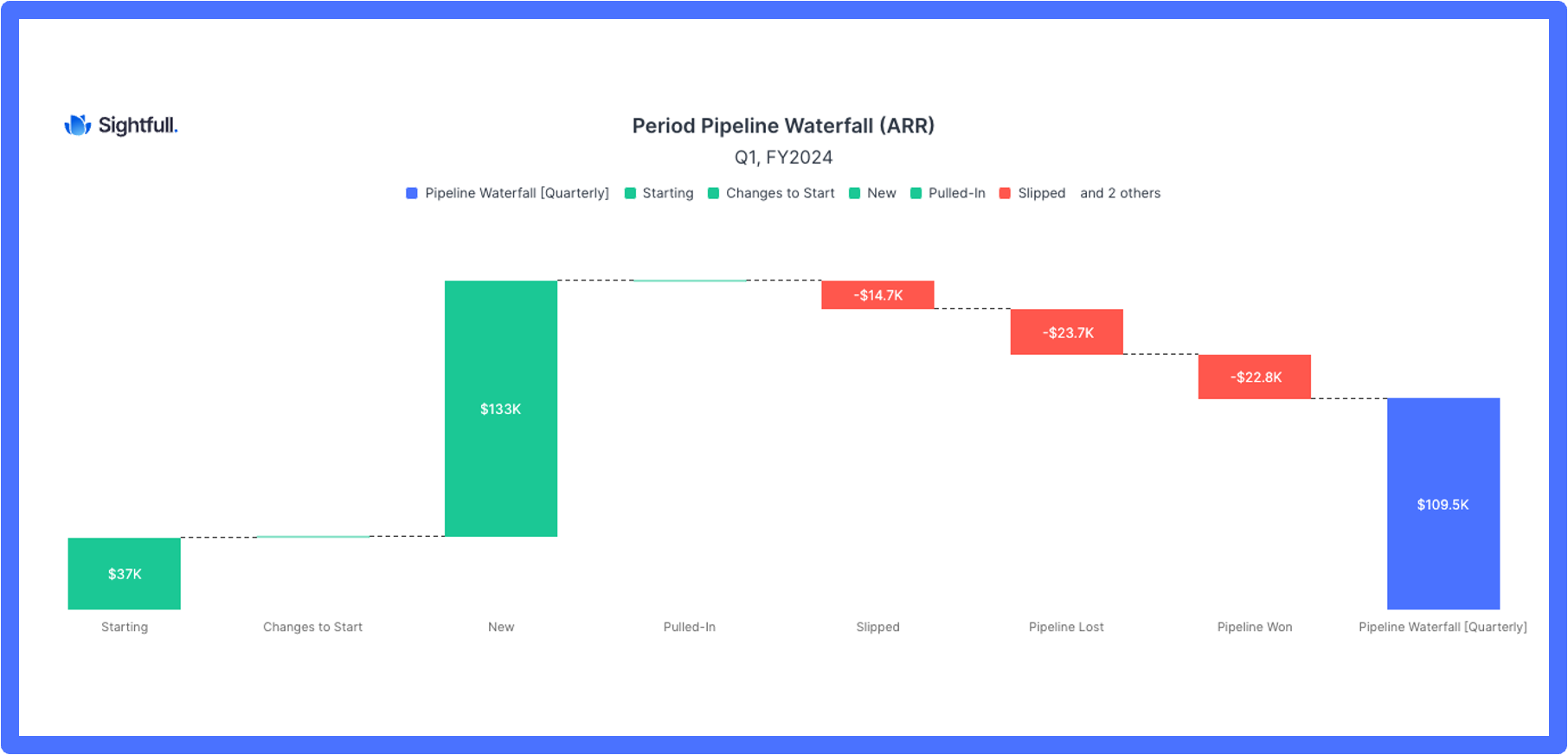
3. Pipeline by Stage Report
The Pipeline by Stage CRM report provides an overview of the pipeline in development during the period, displaying the amount of opportunities that are in each stage of the funnel. By giving you a clear breakdown of how opportunities are distributed, you’re able to to understand the conversion rates of each stage and see if there are any areas where the sales team and potential customers are getting stuck.
Not only does this help RevOps and Sales teams estimate bookings for each quarter, but also highlights areas of opportunity for improvement within the sales cycle.
Common metrics for the Sales Funnel report template include:
- Pipeline by Stage by Cohort: The grouping of opportunities based on their entry into the sales funnel.
- Pipeline by Stage Snapshot: The total value of opportunities within each stage of the sales funnel at the end of a specific period.
- Average sales cycle length: The average number of days that opportunities are active before they are closed.
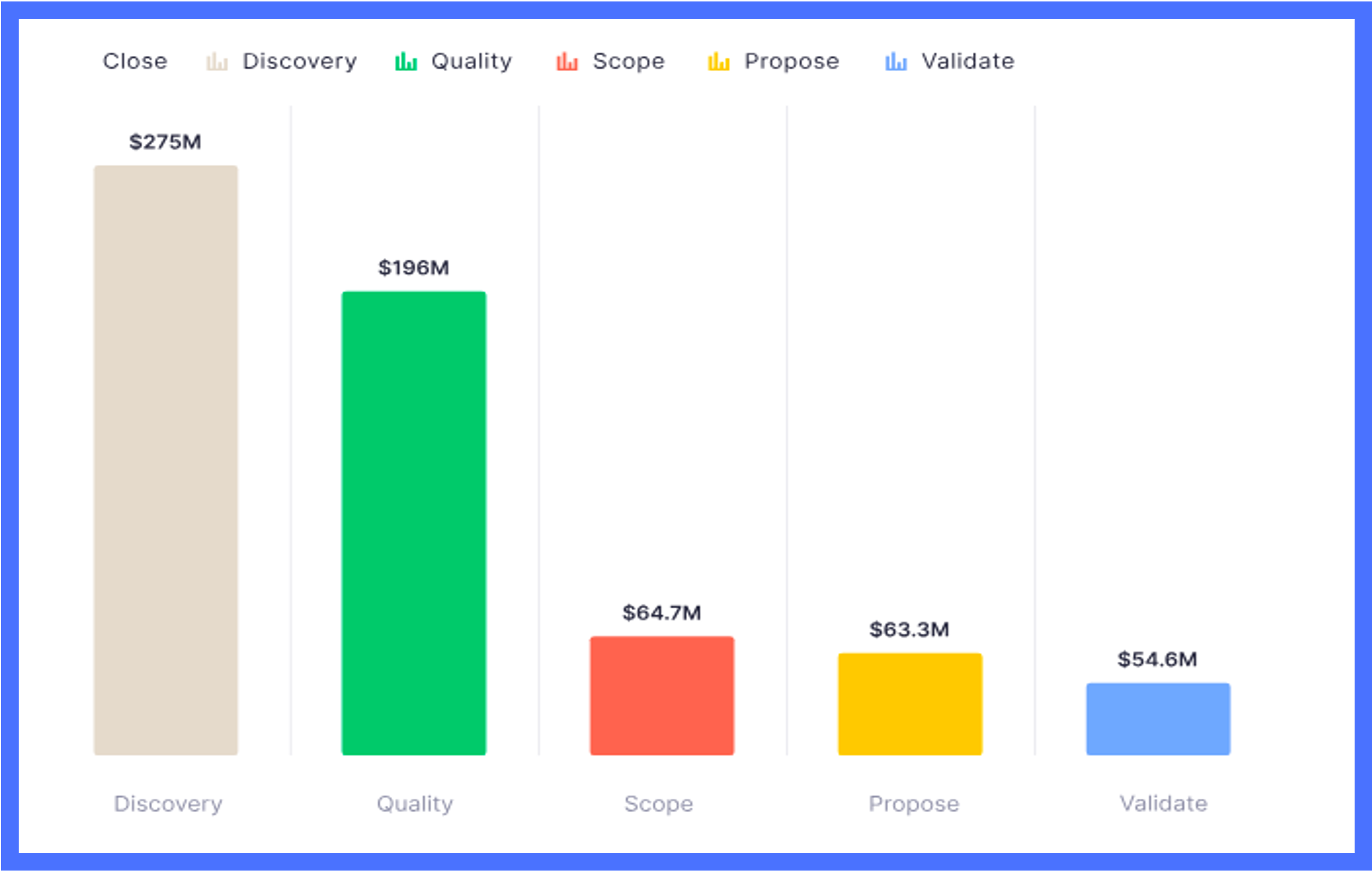
4. Sales Rep Performance Report
Understanding your top-performing sales reps helps you identify the best sales tactics for your organization and encourages friendly competition among the team. Learn who is creating the most deals and closing the most opportunities as well as who has the highest win rates and shortest sales cycles. Identify the team members who aren’t doing as well to support them with additional trainings and resources.
Sales rep performance reports offer insights into:
- Bookings: The total closed won opportunities for the period.
- Pipeline Creation: The number of new opportunities created within the period.
- Opportunity win rate: The percent of closed opportunities that were successfully won. Average sales price: The average price of a closed-won deal within a specific period.
- Average sales cycle length: The average number of days that opportunities are active before they are closed.
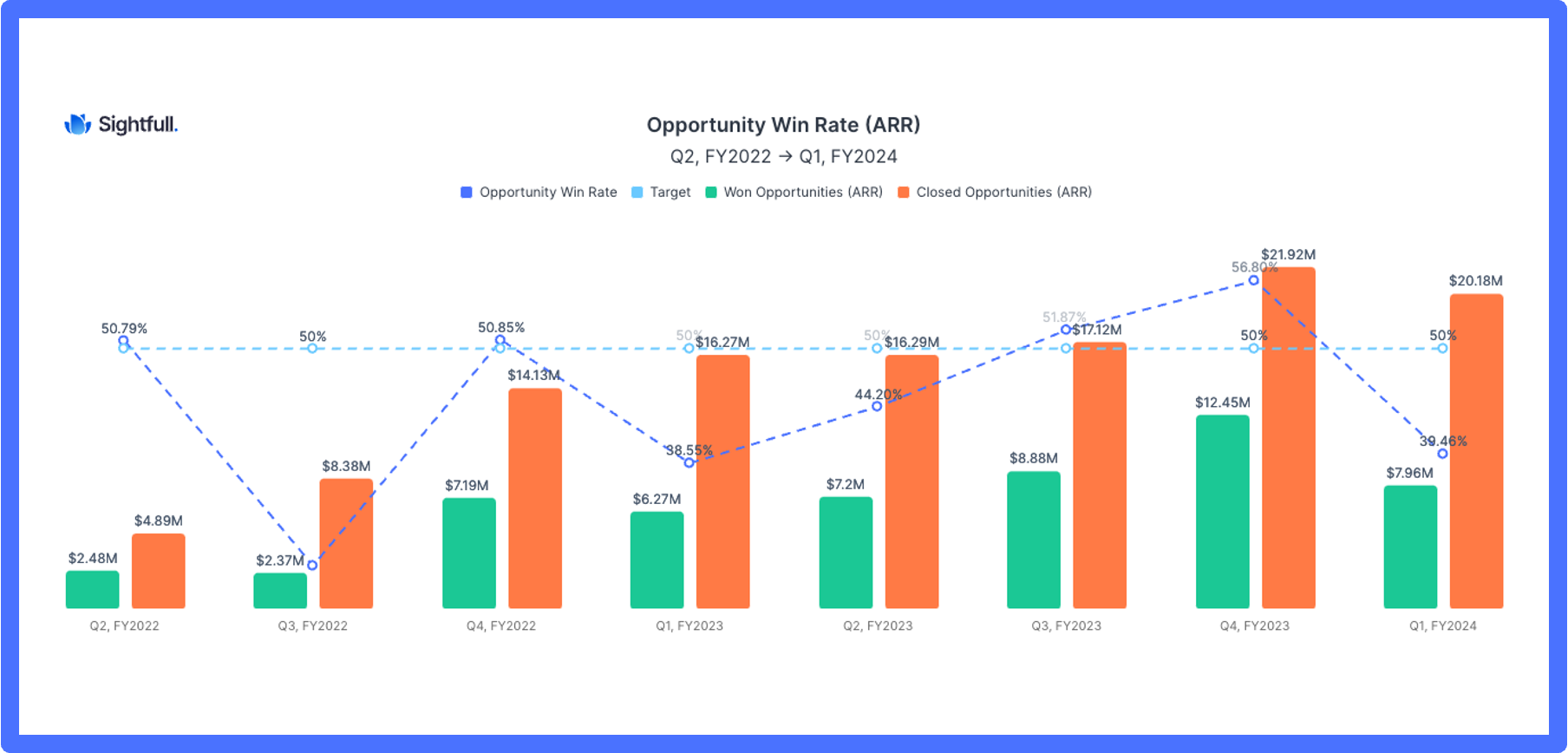
5. Lead Generation Report
By understanding what sources are generating the majority of leads, marketing teams can adjust their tactics accordingly. Lead generation reports also highlight how many leads are making it through each stage of the funnel. This is important for teams to understand the quality of the leads as they’re vetted from leads to MQLs and MQLs to SALs.
Lead generation templates offer metrics such as:
- Leads Created: The quantity of leads created within a specific period.
- Leads Qualified: The number of leads that are qualified by the marketing team as having more interest or engagement and are more likely to become a customer.
- Leads Accepted:The number of leads that are accepted by the sales team and enter the sales funnel.
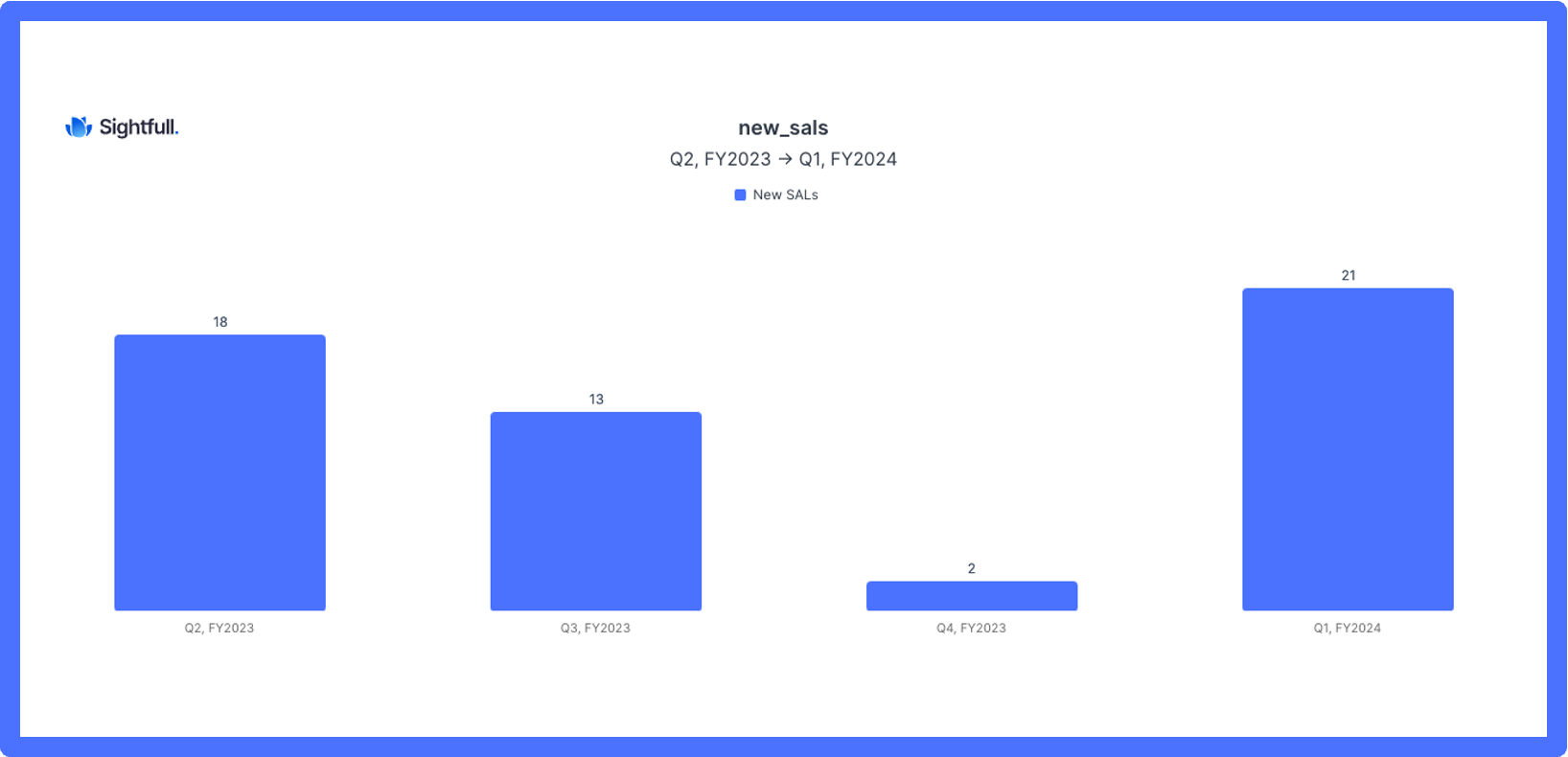
6. Campaign Performance Report
Campaign performance reports help marketing teams refine their strategies by evaluating the effectiveness of each campaign. By understanding the conversion rates of leads to MQLs, marketers know whether or not they’re accurately targeting potential customers. This helps marketing teams improve campaign performance, optimize marketing spend, and fill the pipeline with high-value leads.
Within Campaign Performance Report templates, you’ll get insights to metrics such as:
- Campaign Leads Sourced: The number of leads sourced by marketing campaigns within a specific period.
- Campaign MQL Conversion Rate: The percentage of MQLs that are influenced by campaigns to eventually convert into an opportunity.
- Campaign Lead Conversion Rate: The percentage of leads from a campaign that later converts into an opportunity.
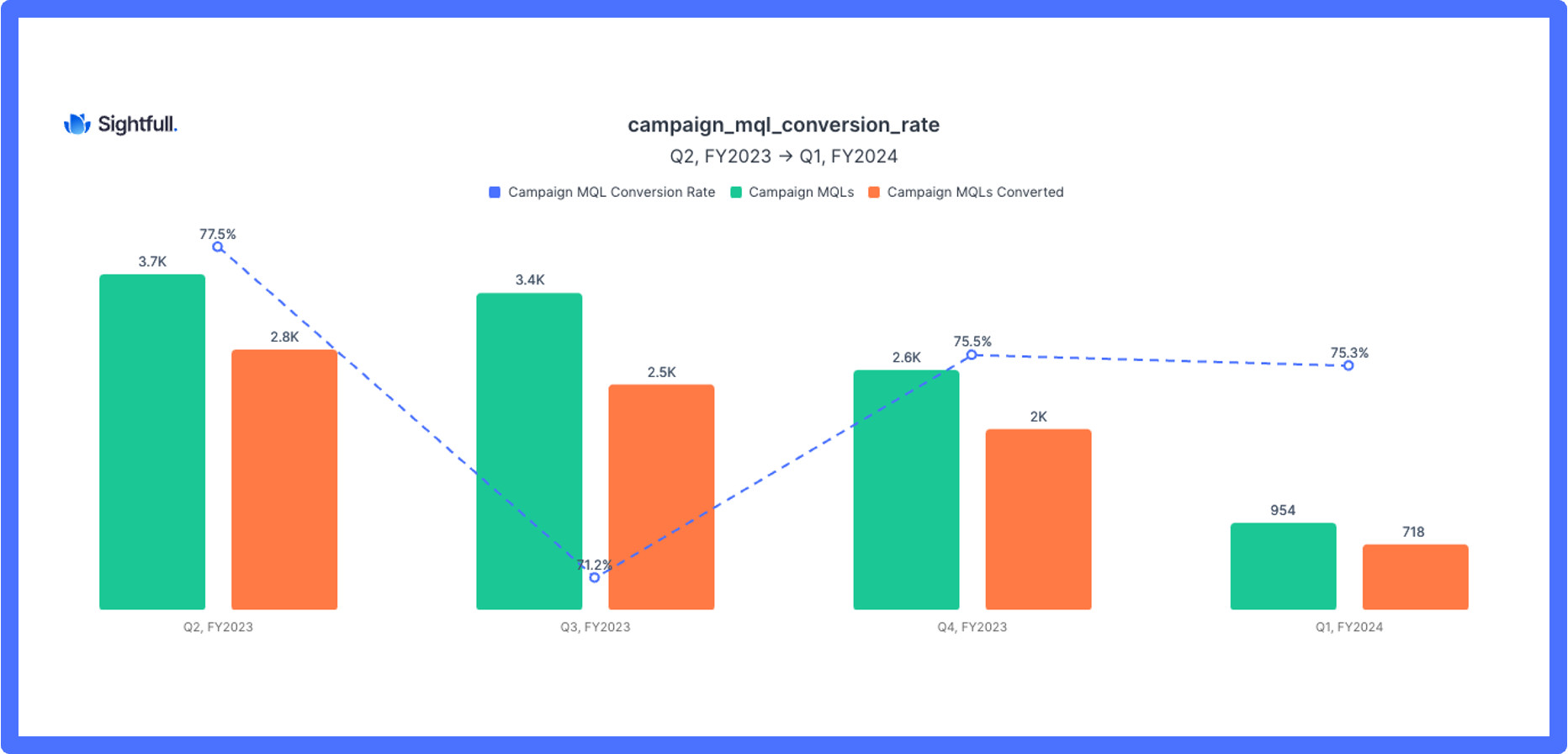
7. Customer Retention Report
Understanding customer retention is crucial to so many teams within the business. From customer success to RevOps, it’s important to keep a pulse on the number of customers that are staying, upgrading, and churning. Retention is an indicator of the health and ability to sustain growth as a B2B SaaS business. It is also a measure of overall customer loyalty and helps highlight areas for improvement within customer service, product, and the overall experience with your business. By analyzing retention, companies can make more informed decisions that guide budget conversations and help allocate resources.
Retention reports typically include metrics, like:
- Net Dollar Retention: The percentage of revenue retained from existing customers over time, including upsells and expansions.
- Gross Dollar Retention Rate: The percentage of revenue retained from customers over a specific period.
- Logo Retention Rate: The percentage of accounts that remain active over a specific period.
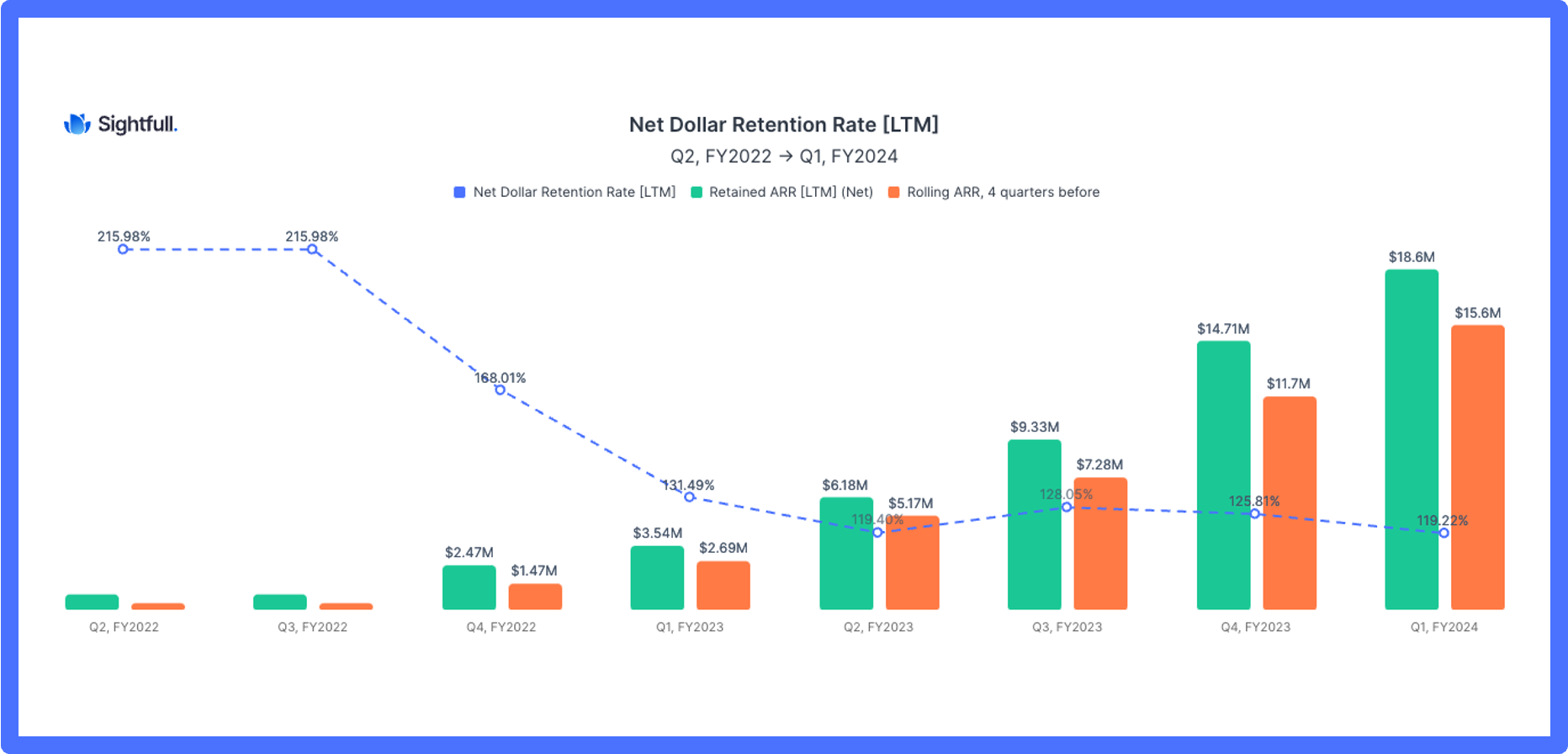
How to Create a CRM Report
Creating a CRM report with Sightfull can be done in four simple steps.
- Choose your template or metric. In the report types above, we include a variety of templates. Or choose from our library of templates and metrics.
- Once you select your metric, connect your CRM. Sightfull connects to a variety of CRM solutions such as Salesforce and Hubspot. Explore our integrations to learn more.
- Then you may define and approve metric calculation, entity, dimensions and relationships
- Access insights in minutes. Sightfull provides easy, self-serve deployment. Build reports and dashboard in just a few clicks.
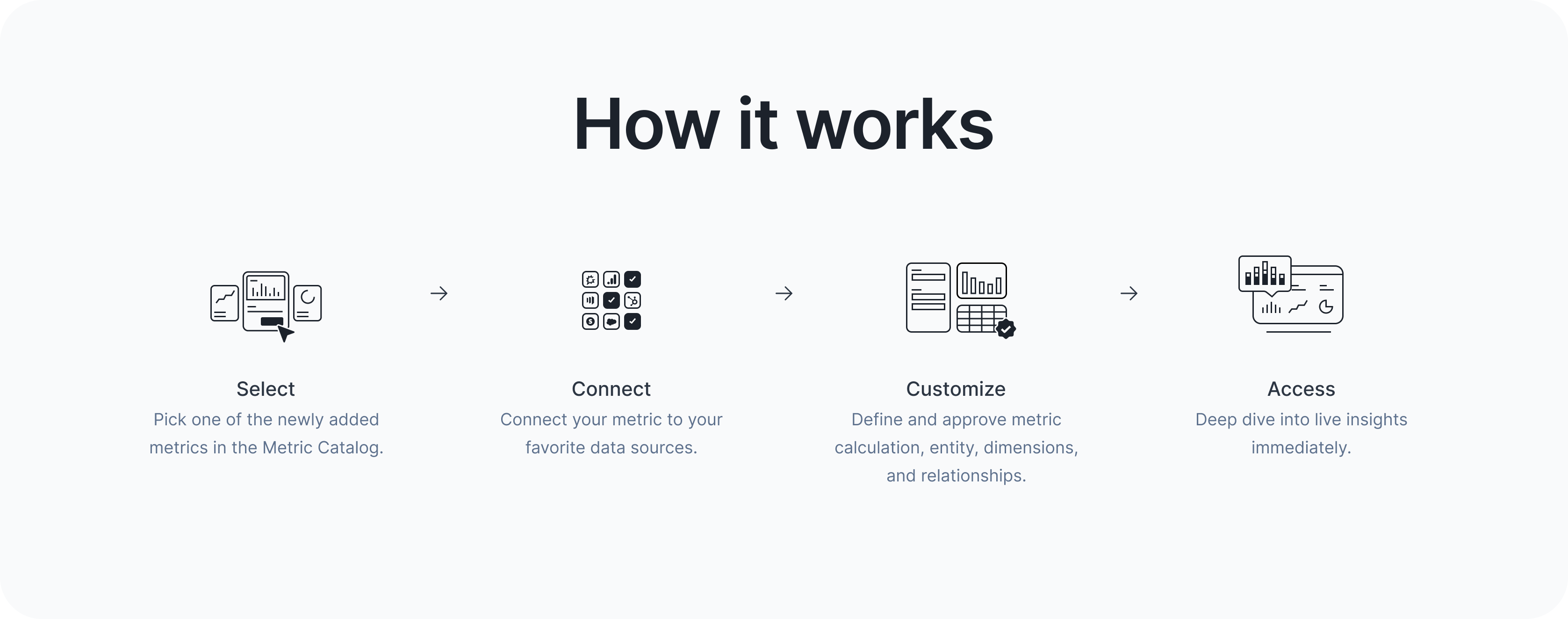
Access our CRM Reporting and Analytics templates

Best Practices for CRM Reporting and Analytics
Before you get started with your own CRM reporting, here are a few best practices to keep in mind for 2025. These tips will set you up for success and help you get the most out of your CRM analysis.
- Clean and validate your data: Regularly cleaning your CRM data is essential for accurate business insights. In fact, Salesforce estimates that 70% of data decays and becomes inaccurate annually. Check for duplicate information and make sure that users are properly trained on how to add and update information within the CRM.
- Create segments: Segmenting data by different criteria, such as customer type or sales region, can provide deeper insights into specific aspects of the business.
- Leverage data visualization tools: Visuals such as charts and graphs can make it easier to digest large datasets, and help you identify patterns and trends.
- Keep an eye on the anomalies: Data points that are outliers could indicate potential issues, unclean data, and are opportunities for further investigation.
- Iterate and refine: CRM reporting is a continuous process that requires adapting and adjusting your reporting techniques as the business evolves. Be flexible to changing needs and willing to explore new data points.
Elevate your CRM reporting

Features for CRM Reporting in 2025
With the rise of AI, CRM reporting technology will continue to improve and evolve, allowing users to glean even more insights from the data. From automating data analysis tasks to enhancing the accuracy of predictive models, we’ll see AI help businesses do more with their data.
Sightfull AI, for example, enables RevOps and go-to-market teams to focus on more complex, strategic projects by automating manual, repetitive tasks. The AI assistant can quickly analyze large amounts of data, identify patterns and trends, and automate repetitive tasks.
Sightfull AI acts as your personalized metric expert to help you navigate your business’ data and unique reporting needs. Ask the AI assistant specific questions about the metrics that you are exploring, request summaries of reports, and status updates on specific KPIs.
Want to learn more? Explore Sightfull AI.
Ready for Insights? Your CRM Reporting Awaits
With CRM reporting at your fingertips, your opportunities and insights await. When analyzed effectively, the reports are so much more than data—they’re treasure troves of actionable insights.
By uncovering trends, identifying strengths and weaknesses, and pinpointing areas for improvement, these reports empower businesses to make data-driven decisions. They can reveal sales pipeline bottlenecks, highlight top-performing marketing channels, and even predict customer churn, allowing for proactive strategies to retain customers.
Uplevel your current reporting practices with Sightfull. With dozens of easy-to-use templates and metrics, Sightfull makes it easy to gain actionable insights from your CRM data.
FAQ
Ready for Insights?
Your CRM Reporting Awaits
Embedded Salesforce Analytics
A comprehensive SaaS reports' library that effortlessly tracks and reports historical data out-of-the-box.
Now, seamlessly integrated into your Salesforce platform.

















